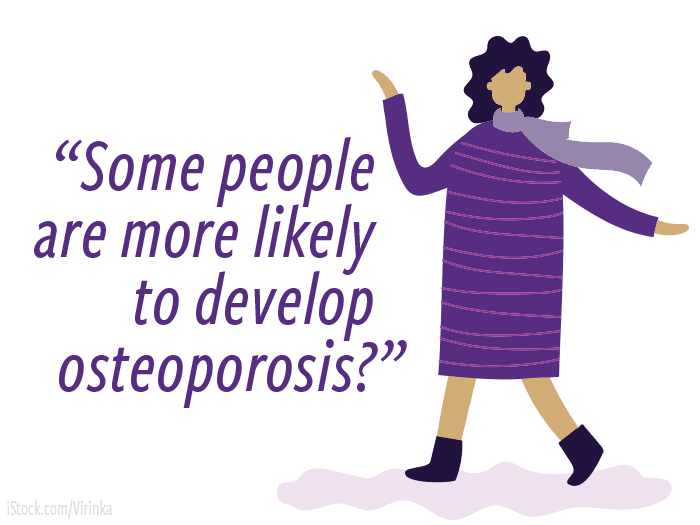Osteoporosis is a loss of bone mass, bone quality and bone strength, resulting in an increased risk for fractures. It can be classified as primary and secondary; primary is common and occurs in both genders, while secondary is less common and associated with the use of medications or as a consequence of other diseases. Today, our focus will be on primary osteoporosis as we continue our discussion on the joys of menopause.
What is osteoporosis?
According to the National Osteoporosis Foundation, about 54 million Americans live with osteoporosis and low bone mass, also called osteopenia. Of these cases, nearly one in two women and up to one in four men age 50 and over are affected. Osteoporosis is most commonly diagnosed in postmenopausal women, although osteoporosis in men is considered an under-diagnosed problem.
Ready for a statistic we don’t want to hear? 50% of women over 50 will experience a fragility fracture as a result of osteoporosis. A fragility fracture is defined as a fracture not caused by trauma, usually caused by a fall. That 52-year old friend of yours who slipped on the ice and fell and broke her wrist? That was a fragility fracture.
The cause of osteoporosis is unknown, but it occurs when new bone formation falls behind bone resorption. In normal bone health, bone remodels. The cells that make bone—known as osteoblasts—are in balance with the cells that facilitate bone resorption, known as osteoclasts. A complex interplay between the amount of force on bone, the endocrine system, nutrition, and other factors cause bone remodeling. Imbalance between the osteoblasts and osteoclasts can occur with decreased gonadal and adrenal function, estrogen deficiency (very often menopause!) and a sedentary lifestyle. Changes in the balance between cell types can also occur with secondary osteoporosis, which may occur with prolonged use of corticosteroids and other medications, alcoholism, malnutrition, malabsorption of nutrients, (think gastrointestinal diseases or lactose intolerance), and endocrine disorders.
Bone health and aging

Bone health starts when we are young. Our bones stop growing shortly after puberty, but our bone mass peaks around the age of 30. This bone mass is our bank for the rest of our lives; from that age on, our rate of bone resorption begins to exceed our rate of bone formation. So, if a young person has struggled with malabsorption digestive issues, has had a poor diet, been treated with certain drugs, struggled with eating disorders, or been very inactive, their bone mass may not be very high by the time they are 30. If you add the loss of estrogen from menopause to already low bone mass, the risk for osteoporosis and osteoporotic fracture increases.
Signs of osteoporosis
So how do you know the signs and symptoms of osteoporosis? Osteoporosis often doesn’t cause any pain, so it’s very possible to have low bone mass but still function and feel fine. Amazingly, people can even have osteoporotic fractures without pain, although many such fractures do cause pain and can create severe changes in function and wellbeing. Fractures very often occur in the upper back (thoracic) or lower back (lumbar) spine. This can cause a rounding of the upper back called kyphosis, or a lateral curve in the thoracic or lumbar spine, known as scoliosis. With either type of curve a person begins to lose height, and internal organs—particularly the lungs—have less room to function. This condensed space can cause pain, reduced lung function, and poor balance—all while having a spine that is not as adaptable to movement. Our risk for other fractures, particularly in the hips, increases as a result as well.
How do I test for osteoporosis?
The key to avoiding osteoporotic fractures is to start with good bone mass and to be screened—and subsequently treated for osteoporosis if needed. The National Osteoporosis Foundation (NOF) recommends that beginning at age 50, all men and postmenopausal women should be assessed for the risk of osteoporosis. Blood tests can determine the amount of vitamin D, calcium, and other bone markers in the body.
Bone Mineral Density (BMD) Test
The test to determine bone density is called a bone mineral density (BMD) test—also known as a DXA (dual energy x-ray absorptiometry) scan. It is a noninvasive, pain-free, quick scan that compares the density of your bone to the average density of bone for a young healthy person. It is scored (called a T-score) according to how closely your bone compares to healthy bone.
The World Health Organization classification for BMD states that if a T-score is at or above -1.0 standard deviation of the average density of bone of a young healthy person, you have normal bone density. Osteopenia is defined as a T-score between -1 and -2.5 standard deviations. Osteoporosis is at or below -2.5.
Treatment for low bone density is often initiated for individuals with T-scores between -1.0 and -2.5 because 50% of fragility fractures occur in this group. I have had friends that are so happy that their post-menopausal DXA scan shows only osteopenia, not osteoporosis. Although this is good, they are still at risk for osteoporosis and may need treatment.
The NOF suggests that anyone with a T-score of -2.0—or even -1.5 if they have at other risk factors—should be treated to reduce fracture risk. Screening for osteoporosis is underutilized and bone loss continues as we age. If your DXA was good at age 48 and you are now 65, another DXA may be appropriate. Share with your primary care provider your complete medical history and ask if BMD testing is appropriate.
Am I at a higher risk for osteoporosis?
Some osteoporosis risk factors are unavoidable: If you are older than 50, are Caucasian or Asian, have an ancestry from northern Europe, have a family history of osteoporosis, are lactose intolerant, or have depression, you’re at higher risk than others. Some risk factors, however, are in your control: Being active, reducing alcohol consumption, not smoking, getting adequate exposure to sun, and eating a diet rich in calcium can build bone mass when you are young and decrease bone loss as you age.

I am Caucasian, of northern European descent, and my mother was diagnosed with osteoporosis. I was at high risk. Add to that a digestive disorder that prevented me from drinking milk in my teen and young adult years, asthma that was treated periodically with corticosteroids, and my chance for osteoporosis escalated. I KNEW that a menopausal DXA scan was not going to give me good news; I was correct. At 46 years old, I had a T-score 0f -2.7. NOT GOOD! Screening and treatment before menopause would have been appropriate for me.
Knowledge is power
Why is knowing you have osteoporosis and treating it so important? Why can’t we just ignore it until we notice a problem? Here is the deal: Most pharmaceuticals for osteopenia or osteoporosis treatment slows down the osteoclastic (resorption cells) over the osteoblastic cells (the builders). In other words, treatment preserves your present bone mass, it doesn’t build more bone. For women, starting with high bone mass at a young age, avoiding modifiable risk factors, getting a BMD test at menopause, and starting early treatment will maintain your best bone mass and avoid the bone mass lost from estrogen deficiency. Your bones will not be those of a 30-year-old, but bone mass will be preserved and fracture risk will be reduced.
Although this all sounds dire, osteoporosis prevention and management has a lot of hope. Treatments are well studied and easily available, and research on new treatments continues. More importantly, individuals with osteoporosis can make a difference in their bone health with the lifestyle choices they make. Practicing self-care in the shapes of not smoking, minimizing alcohol intake, supplementing with calcium and vitamin D, and exercising regularly makes a difference. My next post will be a discussion regarding what women (and men!) can do to prevent and manage their osteoporosis. Stay tuned!
Are you at high risk for osteoporosis, or just want to make sure you’re taking preventive action? Our exceptional physical therapists at the Des Moines University Clinic can help. For more information, to make an appointment for a bone mineral density test, to sign up for exercise classes and special programs, visit the DMU Clinic website or call 515-271-1717.
